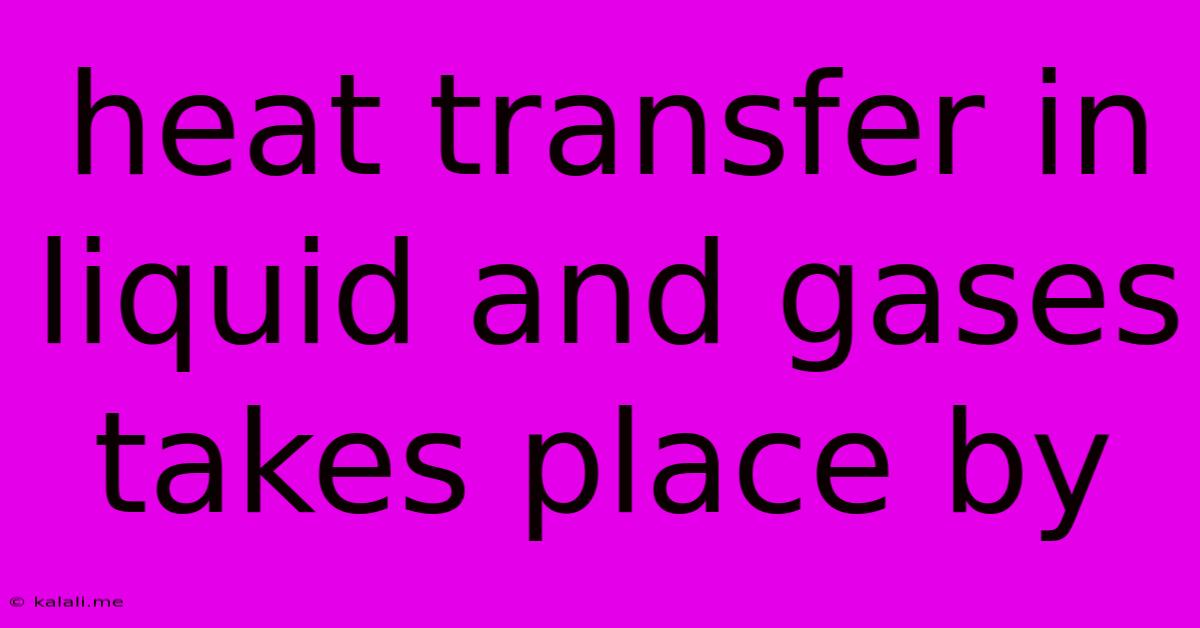Heat Transfer In Liquid And Gases Takes Place By
Kalali
Jun 14, 2025 · 3 min read

Table of Contents
Heat Transfer in Liquids and Gases: Conduction, Convection, and Radiation Explained
Heat transfer is a fundamental process in physics, governing how thermal energy moves from one region to another. Understanding how this happens, particularly in fluids (liquids and gases), is crucial in various fields, from engineering and meteorology to cooking and climate science. This article explores the three primary mechanisms of heat transfer in liquids and gases: conduction, convection, and radiation.
Conduction: The Molecular Dance of Heat
Conduction is the transfer of heat through direct contact between molecules. When a region of a substance is heated, its molecules gain kinetic energy and vibrate more vigorously. These vibrations are transmitted to neighboring molecules, causing a chain reaction that spreads the heat throughout the material. In liquids and gases, conduction is less efficient than in solids because the molecules are further apart and less tightly bound, leading to less frequent molecular collisions. However, conduction still plays a role, particularly in situations where the fluid is relatively stationary. Think of a pot of water on the stove – the heat initially transfers from the hot bottom to the adjacent water molecules via conduction.
Factors affecting conduction in fluids:
- Temperature difference: A larger temperature difference leads to a faster rate of heat transfer.
- Thermal conductivity: Different fluids have different thermal conductivities. Liquids generally have higher thermal conductivity than gases.
- Fluid density: Denser fluids have more molecules per unit volume, leading to more frequent collisions and faster heat transfer.
Convection: The Movement of Heat by Mass Transfer
Convection is the dominant mode of heat transfer in fluids. It involves the physical movement of heated fluid molecules. When a fluid is heated, it becomes less dense and rises, while cooler, denser fluid sinks to take its place. This creates a continuous cycle of rising and sinking fluid, known as a convection current. These currents effectively transport heat energy throughout the fluid. Convection can be either natural (driven by density differences) or forced (driven by external means like a fan or pump).
Examples of convection:
- Boiling water: The hot water rises, while cooler water sinks, creating a convection current that distributes the heat evenly.
- Weather patterns: Warm air rises, creating wind and influencing weather systems globally.
- Heating systems: Forced-air heating systems rely on convection to distribute warm air throughout a building.
Radiation: Heat Transfer Through Electromagnetic Waves
Radiation is the transfer of heat through electromagnetic waves. Unlike conduction and convection, radiation doesn't require a medium to travel; it can occur in a vacuum. All objects emit thermal radiation, the intensity of which depends on their temperature. Hotter objects emit more radiation than cooler objects. In liquids and gases, radiation plays a less dominant role than conduction and convection, except in situations with significant temperature differences or when the fluid is transparent to infrared radiation.
Examples of radiation in fluids:
- Sunlight warming a body of water: The sun's radiation directly heats the water's surface.
- Heat loss from a hot liquid in a container: Some heat is lost through infrared radiation.
Conclusion: A Synergistic Process
Heat transfer in liquids and gases is often a combination of these three mechanisms. For instance, a pot of water on a stove involves conduction from the stove to the bottom of the pot, convection within the water itself, and some radiative heat loss to the surrounding environment. Understanding the interplay of conduction, convection, and radiation is crucial for optimizing energy efficiency, designing efficient heating and cooling systems, and predicting weather patterns. Further exploration into the nuances of each mechanism and their interactions will lead to a deeper understanding of this fundamental process.
Latest Posts
Latest Posts
-
A Key Difference Between Interest Payments And Dividend Payments Is
Jun 15, 2025
-
What Is A Multiple Of 17
Jun 15, 2025
-
Dams Are The Temples Of Modern India
Jun 15, 2025
-
What Is The Factor Of 66
Jun 15, 2025
-
Who Wrote Sare Jahan Se Acha
Jun 15, 2025
Related Post
Thank you for visiting our website which covers about Heat Transfer In Liquid And Gases Takes Place By . We hope the information provided has been useful to you. Feel free to contact us if you have any questions or need further assistance. See you next time and don't miss to bookmark.